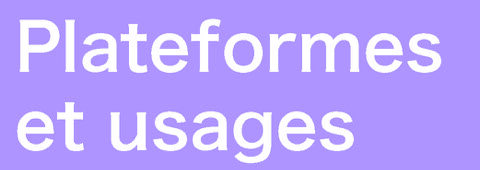Conference reports
Here are some reports on a selection of presentations from the conference “Platforms and uses” by Hugo Samson
In early November, the Université de Montréal's Labo Télé organized the international conference "Plateforms and uses". The present reports, synthesized and digestible versions of a hand-picked selection of lectures, aim to make accessible the knowledge disseminated during this event, which brought together over fifty speakers and a wide range of subject areas.
David Nieborg — Platforms and Cultural Production
Kicking off the first day of the Platforms and uses international symposium, University of Toronto associate professor of media studies David Nieborg presented his conference Platforms and Cultural Production. Based on a book he co-authored, the conference challenged the commonly held idea according to which digital platforms helped in democratizing cultural productions. « It remains unclear how exactly platformizing reshapes cultural creation, distribution, marketing and monetization, » told the speaker, « since it is a process that opens up new opportunities and reconfigures the balance of power within the cultural sphere. » Inherently interdisciplinary, Nieborg’s study engages with the fields of management sciences, political economics, and social sciences to investigate the impact of financial markets on the cultural diversity found within these platforms.
Marie-Caroline Neuvilliers, Gaëtan Rivière — Les communautés des amateurs de ballet sur Instagram: pratiques numériques et créatives
In turn, Marie-Caroline Neuvilliers (Avignon University) and Gaëtan Rivière (CNAC) provided the audience with an analysis of the phenomenon of balletomania as it manifests on the Instagram platform. During the heyday of grand ballets in the nineteenth century, balletomanes were dedicated spectators and connoisseurs who mastered the art’s codes and gathered to discuss it. Today, Instagram accounts perpetuate and actualize balletomania. According to the speakers, even though the digital platform has not brought about significant changes in practice, certain social media-driven customs have blended with traditional codes (such as merchandising), and the analytical approach of the old balletomanes has given way to a more sensitive approach, focused on the appreciation and sharing of emotions in the comments section.
Katharina Niemeyer et Christine Thoër — Appropriations des séries marquantes et réflexions identitaires en contexte de visionnement connecté — expérience de jeunes adultes au Québec.
Katharina Niemeyer and Christine Thoër’s project, which combined field research and creation, aimed to understand the growing popularity of television among young adults. With the advent of digital technology making the viewing experience more intimate, how does this experience engage with the process of identity reflection? Through twenty interviews, the researchers highlighted four forms of appropriation that support identity work: creating memories, creating resources to manage emotions, opening a space where one feels at home, and constructing self-narratives to better understand oneself and negotiate biographical events. Subsequently, an exhibition was created based on the study’s findings.
Carl Therrien — "Is There a Platform in this Talk?" Extensions technologiques, commerciales et culturelles dans le monde de la PC Engine.
“Have you noticed that our platforms are becoming increasingly lousy?” In the room, everyone seemed to agree with this question posed by Professor Carl Therrien (University of Montreal). How can this be explained? Capturing users requires stabilizing their consumption habits, often leading to the standardization of content. According to the speaker, the degradation of platforms is accepted because it is gradual, and it is difficult for users to break free from an ecosystem. At the heart of the conference was the following question: Was it better then? During his presentation, Mr. Therrien compared with humor and erudition the trajectories of the Japanese company NEC and the PC-Engine console to address the phenomenon of normativity that has historically plagued the video game industry.
Frédérique Khazoom — Understanding Netflix as an Assemblage
If many researchers are now interested in studying the Netflix platform, it is partly due to the company’s extreme secrecy, and the fact that it is in constant evolution. For doctoral student Frédérique Khazoom (University of Montreal, University of Amsterdam), the platform should not be viewed as a structure but as an open and mobile assemblage (a term she borrows from French thinkers like Gilles Deleuze.) “Within an assemblage, changes take place in a process of interactions determined in non-linear forms. The past continuously conditions the present.” Analysing several of the platform’s characteristics, such as its use of an ideology of innovation or its global status, from the perspective of the assemblage provided the audience with a critical view of this omnipresent cultural entity.
Guillaume Soulez — De la délibération actée à l'activisme délibératif: vers une alternative à la récursivité?
In the context of the “Critical Perspectives” panel, researcher Guillaume Soulez (Sorbonne Nouvelle) presented possible avenues for studying the transition from the critique of media formats by spectator communities to the creation of new alternative forms of media. Within spaces of deliberation, such as online forums, the critique of “formatted” cinema seems ubiquitous. It is so today, and it has been so for the past couple of decades. The term “flat forms,” (formes plates in French) used to describe this phenomenon of content uniformity, is a play on the word platforms; it is these platforms that structure the industry and influence the power dynamics between users and media. To escape this, the presenter gives the example of David Dufresne’s films (Prison Valley), interactive works that engage the active participation of their viewers.
Edouard Bouté et Raphaël Lupovici — Circulation en ligne des images de la révolte des Gilets jaunes: Au croisement des terrains et des méthodes
The conference by Edouard Bouté (Sorbonne University) and Raphaël Lupovici (Paris-Panthéon-Assas) examined the role of platforms, specifically Facebook, in shaping the criticism of the Yellow Vests (Gilets jaunes) towards the police, the media, and the politicians. Indeed, digital platforms play a significant role in configuring an adversarial framing. During the protests, the Yellow Vests provided a clear interpretation of violent images and videos posted online through the descriptive text space attached to them in the Facebook interface. Furthermore, the website’s “closed groups” structure resulted in political homogeneity among members, making it easier to identify adversaries quickly and promote cohesion. The enlightening presentation by Bouté and Lupovici made clear the political implications of digital platforms.
Florian Body — Indépendance et émancipation créative : la circulation des images dans la scène démo
Do you know about the demo scene? This audiovisual community was at the center of the conference presented by Florian Body (IRCAV.) Its members use programming to create complex animations that explore the technical capabilities of computers and showcase their computer expertise. Without institutional structure and operating in a non-commercial economy, how is the community able to organize massive events year after year? The strong sense of community in this subculture can be partly explained by its emancipation from dominant distribution tools (Twitch, Discord) in favor of independent platforms created by demo practitioners.
Marina Alcaraz et Arnaud Mercier — Comment un rival peut devenir tour à tour concurrent puis allié: le changement de rhétorique des dirigeants de télévision française vis-à-vis de Netflix
If the name of Netflix seems to be on everyone’s lips during the conference, it’s because the company has today become a sprawling and omnipresent cultural entity, inevitably generating vast amounts of discourse. Marina Alcaraz (Echos) and Arnaud Mercier (Université Paris-Panthéon-Assas) presented to the audience an examination of the discourse surrounding Netflix, using as a case study the failed merger of TF1 and M6. If in 2014, the French television industry refuted the distant presence of streaming platforms, their discourse morphed into pleas for cooperation only a few years later. By showcasing the ups and downs in the discourse surrounding Netflix, Alcaraz and Mercier perfectly illustrated how the cultural sphere has had to adapt many times over in response to the rapid rise of the American platform.
Claire Cornillon — Pratiques de réception des séries sur TikTok
Does the name « Kandy Fong » ring a bell? In 1975, she created the first « fan video » by extracting images from the Star Trek series and reassembling them, giving them an entirely new narrative value. In her conference, Claire Cornillon (University of Nîmes) examined how this practice is articulated today around the TikTok social network. By analyzing the history of this format and its various modalities, the speaker clearly demonstrated that the formal tools of these fan videos have, over time, shaped the structure of social networks themselves. Some features of the TikTok application, specifically the editing options like « duet » and « stitch », which are integrated into its interface, indeed appear to have originated from this fan video practice, centered around the re-editing of pre-existing images.
Joyce Cimper — Productions faniques: pour un investissement auditif de la diégèse
The conference by Joyce Cimper (University of Montreal) examined how fan-produced media on social networks can extend the experience of a television series beyond the original work. Ambient videos, for instance, reconstruct a fictional world using sound effects and diegetic music. Footsteps and a crackling piece of music, for example, recreate the sound atmosphere of Hannibal Lecter’s office. In addition to a meticulous investigation of the phenomenon, the conference astutely analyzed how the unique formats of different platforms encouraged creators to produce specific types of videos. This is particularly evident in ASMR roleplay videos, which aim to establish a co-presence relationship with viewers and are, therefore, not well-suited to the short format associated with the TikTok platform.
Charline Blanc — Le tutoriel médiatique: un nouveau genre médiatique?
In the current context of participatory web, the development of tools and viewing platforms enables everyone to create media content without the need for funding. Charline Blanc’s study (University of Technology of Troyes) specifically focused on the relationship between tutorials, both amateur and professional, shared on digital platforms like YouTube, and those broadcast on traditional media today. Educational television programs have indeed existed since 1956, covering a wide range of subjects such as cooking or gardening. However, online, the phenomenon is complexified. Platforms, for example, offer creators the opportunity to sell derivative and digital products (e-books, courses, etc.) as well as gather funding independently. Furthermore, the opacity of how algorithms function sometimes compels them to adopt unique visibility strategies. In short, Charline Blanc’s conference made clear that the shift from traditional media to digital platforms greatly modified the structure of tutorials but changed close to nothing of their content.
Stéfany Boisvert et Dominique Gagnon — Le cas Rings of Power : tensions et factions au sein d'une communauté de fans.
To conduct their study, which focused on the fluctuating relationships within fan communities, Stéfany Boisvert and Dominique Gagnon (UQÀM) utilized the momentum of a controversy, namely the announcement of a diverse cast for the series Rings of Power. The presentation highlighted seventeen online stances taken by fans and anti-fans, some positive (those who approved of the diverse casting choice), while others were negative (from opponents of political correctness to proponents of the great replacement theory.) What the researchers aimed to demonstrate was that the reception of a media work is much more than a meaning-making act, and that perspectives come in a wide variety of distinct stances that need to be nuanced and studied.

Hugo Samson
Hugo Samson is a bachelor's student in comparative literature at the Université de Montréal. He is interested in theories of intermediality and the intersection of art and politics in cultural spaces such as museums, cinemas and theaters. He assists with communications at the Laboratoire CinéMédias, where he works as a research assistant.
